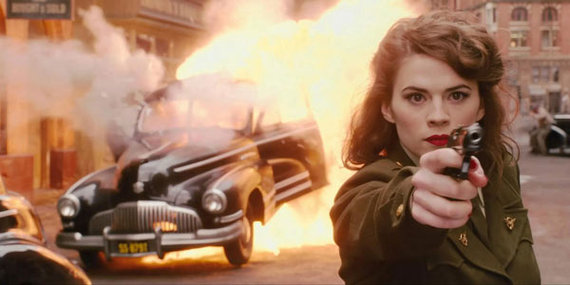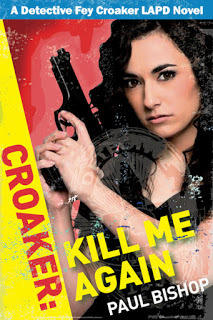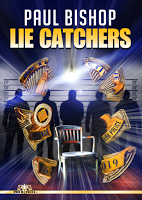When I created the character of LAPD Homicide Detective Fey Croaker, I knew a number of things about her. I knew she was hell-on-wheels as a detective, but consistently made bad choices in her personal life -- including three ex-husbands (a cowboy, a cop, and a clergyman -- the last being the worst choice of all). I knew she was going to be a strong, if not dominant, personality. She had to be a cut above tough in order to handle the five book muck-storm I was planning on throwing her way.
After some of the female LAPD detectives and officers read the Fey Croaker books, I was pleased when they asked me, "How do you know this stuff?" They were referring to the stuff Fey endured in the books which revealed the struggles women in law enforcement face every day. This was stuff their male counterparts never had to deal with -- and there's a bunch of it. Their comments to me exposed just how rare it was for them to find a male colleague who understood these challenges.
I have been lucky. Most of my long term partners on the LAPD have been amazing detectives who just happened to be female. The writer side of me has been paying attention for a long time to how women on the job have to handle or put up with all manner of things male cops don't encounter. Those challenges forced successful female officers and detectives to work harder and smarter to not only do their job, but to also compete for promotions and assignments within the male dominated cop culture.
I've watched closely and made note of the ways female officers responded in these situations. These were the traits and techniques I was able to tap into when bringing Fey Croaker to life on the page. From the responses of female cop readers, it was satisfying to know they felt Fey was truly part of the Sisterhood of Blue.
My latest novel, Lie Catchers, features two top LAPD interrogators, Ray Pagan and Calamity Jane Randall. Whereas the Fey Croaker books were told in the third person, Lie Catchers needed to be told in the first person because of the intense intimacy between characters and readers the story demanded.
Telling the story from Ray Pagan's perspective just didn't feel right. One of Pagan's qualities is the unusual ways in which he approaches situations. This was best experienced from the point of view of another character who would come to understand Pagan along with the reader. That put me, as the writer, inside the head of Calamity Jane Randall -- a very good detective, but still a woman who doesn't truly understand herself. To become a great detective, a great interrogator, she needs Pagan to lead her on the path to self-discovery. He also needs her to save him from himself.
I didn't want Pagan and Randall to be a riff on Holmes and Watson. I wanted the Pagan/Randall dynamic to be a symbiotic, equal partnership. Randall wasn't just there to assist and marvel at Pagan's brilliance -- a foil used to listen while Pagan explained his cleverness. Randall is her own woman with her own strengths. Yes, sometimes Pagan acts as a mentor, but I wanted there to be an equal number of times when Randall's actions saved the day. Jane needed to be a leader, not always a follower.
But here was the challenge. As a male, writing in the third person about a female main character like Fey Croaker was one thing. Actually getting inside Jane Randall's head to tell the story from her perspective as a woman was entirely another.
I had been living with the characters of Pagan and Randall in my brain for quite a while before I started writing. As I prepared to start tapping out words, I found I actually knew more about Jane than I did about Pagan. I knew she was very different to Fey Croaker. The LAPD of 2015 was much different than Fey's LAPD of the 1980s. Women were now fully integrated into the department from the street to the rarefied air of top administration. The last bastion of male dominance, SWAT, was on the verge of being rightfully invaded. All of this made Jane's experiences on the job much different than Fey's.
However, it wasn't just the changes in the department separating Jane from Fey. Jane's personality was very different. She was a touch more tentative, a little less self-aware. She was no less of a detective, but her approach was much more stealthy. Fey reacted, charging into situations until she crushed them. Jane had no problem taking physical action, but she quickly assessed situations and smoothly responded in whatever way would achieve her goal with a minimum of shattered glass. This was the biggest difference between the two characters -- and that difference is what gave Jane the ability to become a skillful interrogator.
Interrogation is all about becoming the person the suspect needs you to be in order to confess. You can't do that by reacting... You have to be able to respond. When a doctor gives you a prescription and you react to the drug, that's bad. If you respond to the drug, that's good.
Fay Croaker. Calamity Jane Randall. Two very strong female characters, yet quite unalike. As a writer, however, I needed to probe what these two characters had in common. What were the shared traits that made them strong females?
Nobody will argue men and women communicate differently. Who buys all the self-help books on communication? Women. Who do they buy them for? Men. At the basic level, when men talk they report -- I did this, I saw that. When women talk they rapport -- I feel this way, I understand what you're going through. While women on the job have been found to take on more male characteristics, because of the nature of the work, they still communicate on a different wavelength than men. All of this has to be taken into consideration when creating a strong female character who is actually female.
You cannot create male characters and then simply switch their genders and expect to have a fully rounded female character on the page. Women's internal dialogue is different, their thought process often zigs when a man's zags. Again this isn't necessarily good or bad, but it is definitely different. If you don't address that difference, your female characters will be flat or at best two dimensional.
Neither Fey nor Jane are simply male characters with bigger breasts. Neither are they male fantasy figures with no depth. Their priorities and outlooks are uniquely female. They handled situations differently than their male counterparts -- again, not always better, but different.
I had to pay attention not to let either character fall into the bitch trap -- having them behave in the shrill, grating, manner of an unreasonable harpy. I needed them to be able to show their strength in their behavior toward other female characters without clashing. Women talk to each other, often understanding each other on an empathic level to which most men are blind.
Both Fey and Jane are strong enough to make decisions with a direct impact on the story. Neither simply wait around on the page for other characters to make things happen. Fey is definitely no tag-along. Jane while initially swept up and unbalanced in Pagan's world, quickly finds her feet and takes initiative back into her own hands. These traits are part of their personalities -- their character DNA.
As I wrote both of these characters -- quite a few years apart -- I felt an obligation to maintain their female integrity. I need to protect them from falling into the clichés so often placed on female characters created by male authors. By doing so, both Fey and Jane covered my back by coming alive on the page and talking to me as I put them through the story's paces.
Pay attention to the details of your female characters. Let them live and breathe as females -- not male clones. Use the differences to give depth to your female characters, and they will reward you by making your male characters stronger and better.
This is a man's world, but it ain't nothin' without a woman.
ABOUT THE INTERVIEWER: Novelist, screenwriter, and television personality, Paul Bishop spent 35 years with the Los Angeles Police Department, where he was twice honored as Detective of the Year. He continues to work privately as an expert in deception and interrogation. His fifteen novels include five in his LAPD Homicide Detective Fey Croaker series. His latest novel, Lie Catchers, begins a new series featuring LAPD interrogators Ray Pagan and Calamity Jane Randall.
WEBSITE TWITTER FACEBOOK AMAZON



